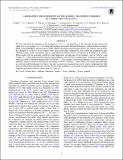| dc.contributor.author | Hell, N. | |
| dc.contributor.author | Brown, G. V. | |
| dc.contributor.author | Wilms, J. | |
| dc.contributor.author | Clementson, J. | |
| dc.contributor.author | Liedahl, D. | |
| dc.contributor.author | Porter, F. S. | |
| dc.contributor.author | Kelley, R. L. | |
| dc.contributor.author | Kilbourne, C. A. | |
| dc.contributor.author | Beiersdorfer, P. | |
| dc.contributor.author | Grinberg, Victoria | |
| dc.date.accessioned | 2017-06-22T17:02:14Z | |
| dc.date.available | 2017-06-22T17:02:14Z | |
| dc.date.issued | 2016-10 | |
| dc.date.submitted | 2016-05 | |
| dc.identifier.issn | 1538-4357 | |
| dc.identifier.issn | 0004-637X | |
| dc.identifier.uri | http://hdl.handle.net/1721.1/110171 | |
| dc.description.abstract | We have measured the energies of the strongest 1s–2ℓ (ℓ = s, p) transitions in He- through Ne-like silicon and sulfur ions to an accuracy of <1 eV using the Lawrence Livermore National Laboratory's electron beam ion traps, EBIT-I and SuperEBIT, and the NASA/GSFC EBIT Calorimeter Spectrometer (ECS). We identify and measure the energies of 18 and 21 X-ray features from silicon and sulfur, respectively. The results are compared to new Flexible Atomic Code calculations and to semi-relativistic Hartree–Fock calculations by Palmeri et al. (2008). These results will be especially useful for wind diagnostics in high-mass X-ray binaries, such as Vela X-1 and Cygnus X-1, where high-resolution spectral measurements using Chandra's high-energy transmission grating has made it possible to measure Doppler shifts of 100 km s[superscript -1]. The accuracy of our measurements is consistent with that needed to analyze Chandra observations, exceeding Chandra's 100 km s[superscript -1] limit. Hence, the results presented here not only provide benchmarks for theory, but also accurate rest energies that can be used to determine the bulk motion of material in astrophysical sources. We show the usefulness of our results by applying them to redetermine Doppler shifts from Chandra observations of Vela X-1. | en_US |
| dc.description.sponsorship | United States. National Aeronautics and Space Administration (work orders NNX/2AH84G) | en_US |
| dc.description.sponsorship | United States. Department of Energy (Contract DE-AC52-07NA27344) | en_US |
| dc.description.sponsorship | Smithsonian Astrophysical Observatory (contract SV3-73016) | en_US |
| dc.language.iso | en_US | |
| dc.publisher | IOP Publishing | en_US |
| dc.relation.isversionof | http://dx.doi.org/10.3847/0004-637x/830/1/26 | en_US |
| dc.rights | Article is made available in accordance with the publisher's policy and may be subject to US copyright law. Please refer to the publisher's site for terms of use. | en_US |
| dc.source | IOP Publishing | en_US |
| dc.title | LABORATORY MEASUREMENTS OF THE K-SHELL TRANSITION ENERGIES IN L-SHELL IONS OF SI AND S | en_US |
| dc.type | Article | en_US |
| dc.identifier.citation | Hell, N., G. V. Brown, J. Wilms, V. Grinberg, J. Clementson, D. Liedahl, F. S. Porter, R. L. Kelley, C. A. Kilbourne, and P. Beiersdorfer. “LABORATORY MEASUREMENTS OF THE K-SHELL TRANSITION ENERGIES IN L-SHELL IONS OF SI AND S.” The Astrophysical Journal 830, no. 1 (October 4, 2016): © 2016 The American Astronomical Society | en_US |
| dc.contributor.department | MIT Kavli Institute for Astrophysics and Space Research | en_US |
| dc.contributor.mitauthor | Grinberg, Victoria | |
| dc.relation.journal | Astrophysical Journal | en_US |
| dc.eprint.version | Final published version | en_US |
| dc.type.uri | http://purl.org/eprint/type/JournalArticle | en_US |
| eprint.status | http://purl.org/eprint/status/PeerReviewed | en_US |
| dspace.orderedauthors | Hell, N.; Brown, G. V.; Wilms, J.; Grinberg, V.; Clementson, J.; Liedahl, D.; Porter, F. S.; Kelley, R. L.; Kilbourne, C. A.; Beiersdorfer, P. | en_US |
| dspace.embargo.terms | N | en_US |
| dc.identifier.orcid | https://orcid.org/0000-0003-2538-0188 | |
| mit.license | PUBLISHER_POLICY | en_US |
